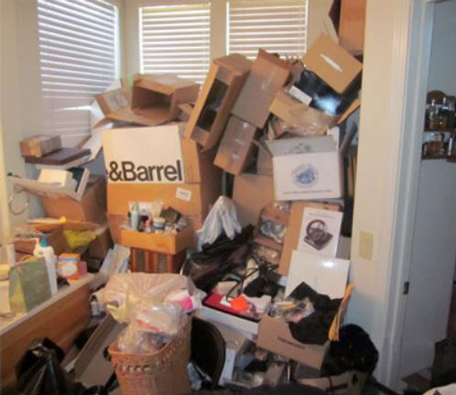- City Fajr Shuruq Duhr Asr Magrib Isha
- Dubai 04:27 05:45 12:20 15:47 18:49 20:07
 (Photo credit www.hoarders.com)
(Photo credit www.hoarders.com)
Do you find yourself cringing at the thought of throwing away worthless items that you’ll never use again?
Do you stock and pile up useless or broken items for no rational reason?
 (Photo credit www.hoarders.com)
(Photo credit www.hoarders.com)
Are you unable to access other areas of your house because of the clutter?
And, do you still have cassette tapes?
If you’ve answered ‘yes’ to all of these, then congrats to you. You are officially a hoarder.
And don’t mistake that for being a collector, they are both different from one another.
“Collectors feel proud of their possessions and keep them well organised and maintained, but hoarders feel embarrassed by their possessions, and have them scattered randomly.” Dr Fiona Barzi.
Speaking to ‘Emirates24|7’, the Consultant Health Psychologist explained added: “This sort of clutter by hoarders often results in the loss of a proper working and living space, and they usually feel ashamed or depressed after a new round of shopping.”
Most experts agree that hoarding is a type of obsessive-compulsive disorder, as well as a manifestation of depression, social anxiety, or even a bi-polar disorder.
Hoarding disorder can start very early in life and often gets worse over time.
Dr Fiona said efforts to throw items away often trigger intense emotions that can feel overwhelming, so the hoarder usually tends to delay or avoid making decisions about what can be thrown out.
However, there are many possible reasons for keeping so many of these items – sentimental reasons, they might come in handy one day or just because they look beautiful.
Dr Fiona said: “It’s not easy treating compulsive hoarding but it can be overcome, and the main treatment for this condition is through Cognitive-behavioural therapy (CBT).”
This type of treatment encourages people to talk about how they think about themselves, the world and other people, and how what they do affects their thoughts and feelings.
“We help them understand why it’s difficult for them to throw things away, and why their clutter builds up.”
She added: “There’s also a few practical exercises and a plan that we develop for the patient to follow.”
She stressed that it’s very important that “they take responsibility for getting rid of the clutter from their home, which we support and encourage”.
She also shared a few tips to get you started on de-cluttering the mess:
Start slow – Do not go through your home and throw everything into the dump at once, as tempting as it sounds. It only leads to negative feelings of regret and anxiety. Ideally you should start slowly and go through one collection each week.
Box it - If you can’t decide to throw away or keep an item, keep it in a box for 6 months. If you don’t open that box before then, you can let the item go without regret. This technique has proved to be a success with most people.
Decide now - Stop placing items aside and just get things done. Decide then and there.
Donate, recycle or sell - We just love saving memorable objects from our childhood and having a look every now and then, but, again part of the entire clutter, so just keep 1 or 2 of them and as the rest of them, donate, recycle or sell them off.
The psychologist added that regular CBT sessions over a long period of time are usually necessary and should include some home-based sessions, working directly on the clutter.
This requires commitment and patience, as they work on a path to improving the person's decision-making and organisational skills, helping them overcome urges to save, and ultimately clear the clutter, room by room.
Dr Fiona explained that it’s important that they choose to throw or donate the items themselves.
“We normally will never throw any of their items away, but we will help guide and encourage them to do so,” she said.
The patient then gradually becomes better at throwing things away.
“We also encourage them to keep a daily log of what they have purchased to monitor incoming clutter.”
At the end of treatment, the person may not have cleared all their clutter, but they will have gained a better understanding of the problem.
Dr Fiona continued: “They will have a plan to help them continue to build on their successes and most importantly, avoid slipping back into their old ways.”
![]() Follow Emirates 24|7 on Google News.
Follow Emirates 24|7 on Google News.